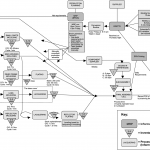|
It is with great frequency hotels and resorts ask us to help them put marketing and customer service solutions into Standard Operating Procedures for their staff to follow. While we understand the importance of procedures in the back-of-the-house, we find a need for flexibility on its use in the front-of-the-house. I want to clarify, this is not about production SOP’s and Six Sigma, this is about forcing processes on customers.
Standard Operating Procedures Mapping
 Sample of mapping When Valorem Group approaches the creation of SOPs for clients, we start by following the guest journey and connecting the dots along the way to key internal positions that are key drivers of customer satisfaction. We look at the breakdown in repeat booking ratios of unsatisfied guests and analyze their dissatisfaction. In 67% of the cases we have studied, we can peg back dissatisfaction SOP’s. Yes, the typical escalation processes for improving service are really destroying service, loyalty and the lifetime value of customers.
While this discovery process seems simple, it takes time to rebuild the right procedures, and even more time to create the strategy to eliminate procedures. We find that many companies with reduced staffs have limited time to look at the perspective from the outside in or from the inside out to establish the best and most sensible operating procedure. Companies simply call on their employees to create the processes and procedures. While staff is excellent at working to produce requests from their leaders, they may not be as proficient at mapping the internal value chain and allocating the right steps for the right resources. In most cases, the staff simply doesn’t have the full range of internal visibility or the clear perspective of the customer’s personal value chain to determine the best approach to deliver service based on needs. Yes, we are saying it; there is a huge gap between internal mapping and external mapping, and we find that we create policies that usually don’t satisfy customers but do satisfy the immediate need of managers who cannot themselves create proper SOPs.
Standard Operating Procedures that work
We have tested procedures using real guests, real staff, and this is what we have found:
1. Based on observations at each touch point, both internal and external, most written policies are barriers to guest satisfaction and add frustration for internal players who had no input in the co-creation of procedures.
2. The only solution is the procedure itself, and how it satisfies management with no regard to internal or external customers, value chains, or satisfaction. In such a collaborative corporate environment, we bypass the team for the sake of speed demanded by managers.
3. We find that when the Directors request continuous SOP’s be written, that it becomes clear to the staff that while there is good “management” there is not real leadership. Why do we say this? The standard reaction for a manager if something is out of control is to create more process and procedures in order to manage the situation better the next time. At the executive leadership level, vision, strategy, and reaching goals are the primary objectives, not battening the hatches on the ship for every wave. We suggest laying down a customer service vision based on common sense. What “common sense”? We find a key difference between managers and leaders in the case of trust. Manager’s don’t think common sense is found in the ranks, leaders trust the common sense of their staff.
4. How these procedures are communicated is lackluster and directive. In today’s highly engaging environments, it is common to see how procedures and processes break all the rules, and are one way streets directed by employees on other employees. Collaborative mapping is never an option in the case of a time-constrained environment.
5. Bad procedures are always communicated to guests whether, directly or indirectly, giving guests a worse experience than the one they are probably complaining about in the first place. We shot ourselves in the foot with an abundance of SOP’s that make dealing with our brands intricate at best.
6. By setting up excessive SOP’s we eliminate any use of “common sense”. From our observations, those companies with tight management see a reduction in motivation and in the use of common sense always referring to SOP’s in lieu of thinking. The lack of motivation in a procedure-driven company is at least 28% more than in less procedure-driven companies. Yes, they are less motivated the more processes are instilled. Employee attrition is higher, even in a time or low employment, and guest satisfaction is lower, with customer loyalty 21% lower due to constraints placed on guests to reach satisfaction.
7. The most challenging thing about procedures is that it is a huge tradeoff for revolutionary thinking and action. Procedure driven companies are evolutionary not revolutionary. Imposing constraints keeps employees thinking inside the box and increases the topple rates of companies, even those that appear clear market leaders today, tomorrow will fall. Do you think IBM, Microsoft and HP are revolutionary? How long do you give them? Is Apple evolutionary or revolutionary? Test it. Call each with the same complaint and gauge your level of frustrations. Yes, you can almost certainly peg it back to the blocking of satisfaction through constraining SOP’s. Are you revolutionary?
8. Procedures focus on reducing risk, eliminating the sporadic wins that produce high revenue and increase market share. We are creating process-driven companies that turn out to be mediocre and will “lead” [in it’s manager’s heads] but always from behind.
The Standard Operating Procedure Solution
The solution is to analyze the custom journey, the solution needed, why the SOP is being created in the first place, the result of the SOP, and then map internally collaborating in building a world-class guest service experience. Or, you could create a world of procedures and put an end to loyalty and profits. You decide.
Read more articles about resort marketing. Want to get your SOP’s focused on providing the best guest experience? Want to have a greater lifetime value of your customer? Contact us at 617.939.9698 for info, our first consultation is complimentary.
|
